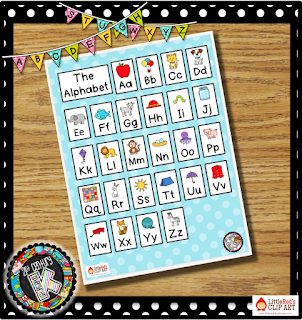12.2.20
Teaching the Alphabet in Kindergarten
How do you teach the alphabet in Kindergarten? Do you focus on a single letter a day or a week? Do you teach letters in clusters or individually? Do you start at A and end with Z or reorder the letters? There are so many ways to teach the alphabet to young students that lesson planning could easily become overwhelming. Like you, I've used a combination of approaches to create a sense of balanced literacy.
One of the best books I've ever studied on the topic of reading instruction is The Next Step Forward in Guided Reading by Dr. Jan Richardson. Dr. Richardson is a leading expert and researcher in the field of reading. When I heard her present at the Kentucky Reading Association conference she said that we should teach the entire alphabet early in the kindergarten school year and "with a sense of urgency." The number of letter names children can identify at the beginning of the school year is in direct correlation to the level at which they will be able to read at the end of the school year. Teaching the letter names as quickly and early as possible is vital to high success in learning to read. The sooner students know the majority of letter names (out of 52 total - upper and lower), the higher their reading level will be at the end of the year. (Read all about Dr. Richardson's research here.)
This study made me really analyze my Kindergarten literacy instruction. So, I thought about my entire school day and listed the instructional strategies and programs I use that relate to literacy.
- Scott Foresman Reading Streets Basal Reading Series
-Saxon Phonics
-Michael Heggerty Phonological Awareness
-Stepping Stones to Literacy
-Guided Reading
-Writer's Workshop
-Literacy Centers
WHOA! When I list all of those teaching approaches I realize that I'm most likely over-complicating my instruction and that my struggling students may be lost in a sea of programs and options for learning. So this year I decided to streamline my alphabet instruction (at the least) in order to provide consistency, especially for my struggling students. I decided to go with the Saxon Phonics as my main source of phonics and alphabet curriculum. I use only Saxon's letter picture cues and scope and sequence.
I started the school year with a boot camp style sequential review - teaching one letter per day for the first 26 days of school. We used our "My First Letters & Words" interactive notebook to review each letter's sound(s) and written formation along with exploring tons of fun online songs and videos for each individual letter with our Interactive Alphabet Review. The results from this alphabet introduction were amazing! Students who already had a grasp of most letters were able to firm up their letter knowledge quickly. Students who knew a few letters, picked up a few more. Students who did not know any letters at least had a new frame of reference for what a letter is and the purpose letters serve. This is the first year that MOST of my students new ALL upper and lowercase letters by the first quarter assessment and I'm sure it's due to this beginning of the year alphabet review.
After our review of all the letters I fell in with our Saxon Phonics curriculum. This scope and sequence covers one letter per week and teaches letters in a particular orders. Some vowels and easier consonants are taught early on in order to give students enough letter-sound knowledge to be able to make and break CVC words within the first few weeks of instruction. Saxon Phonics is an explicit, teacher led program and it isn't a comfortable fit for all teachers, but it is a great learning tool - for teachers just as much as students!
In guided reading groups we review all letters and sounds everyday until students have mastered the list. I do this with an Alphabet Chart (read more about that here) and with individualized cards for finger tracing. When students are struggling with the entire alphabet, it's best to break it into smaller parts, beginning with the letters in the students' names. It may also help to pull out just the vowels when students have mastered consonants. This is where the individual finger-tracing cards come into play.
This main thing with alphabet instruction is to keep the system consistent. We don't switch between "hooks" or cues for letters and sounds. I use the same picture cue and the same language for forming letters every single day. This provides a hook on which students can hang their learning for a particular letter/sound that won't fail them at other times in the classroom routine. So, regardless of your "program" (or programS like in my case!) you need to find a way to simplify letter instruction so as not to "muddy the waters" of your students' learning.
Alphabet review is just one part of my daily guided reading routine. If you are interested in learning the Top 3 Must-Do's in every Kindergarten Guided Reading Lesson, then be sure to sign up and grab this free workbook and improve your Guided Reading instruction today!
Subscribe to:
Post Comments (Atom)











No comments:
Post a Comment